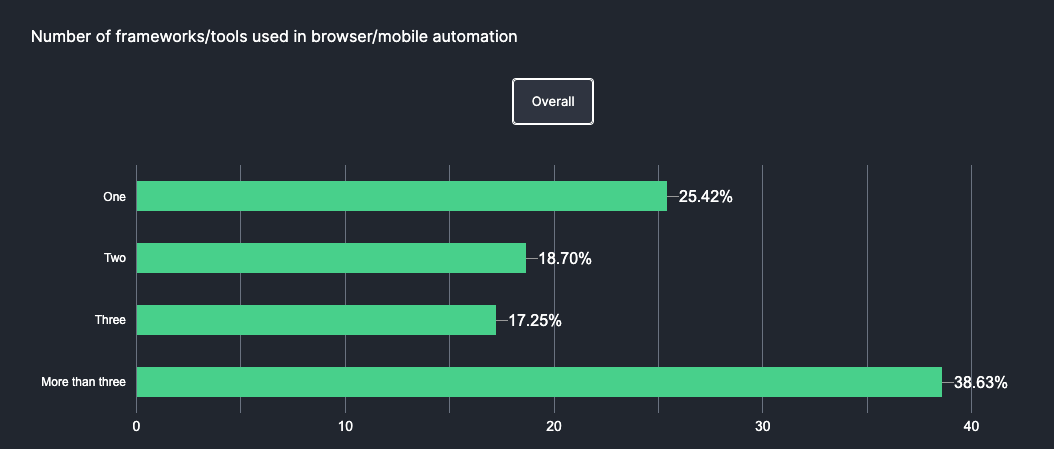Optimizing QA and Testing with Multi-Framework Strategies
Ilam Padmanabhan
Posted On: March 19, 2024
![]() 38913 Views
38913 Views
![]() 9 Min Read
9 Min Read
Imagine a scenario: You’re tasked with managing an IT environment with two systems. Each requires its unique set of tools and frameworks. Initially manageable, right?
Now, introduce a third system based on another technology into the mix, and suddenly the complexity compounds. A typical medium/large-sized company usually operates with multiple tech stacks that need to work in sync to deliver the product or service to their customers. The complexity grows higher especially if the company is a result of multiple mergers and acquisitions.
Any quality-focused company would want all their product changes tested before they expose it to their customers. How do they go about choosing the right framework for their QA setup to cover it all? I’ll give you the answer: Multi-Framework strategy.
Understanding the State of Test Infrastructure
A recent survey by LambdaTest shows that the vast majority of organizations opt for multiple testing frameworks to fulfill their automation needs. Over 74.6% of surveyed organizations deploy two or more frameworks, with over 38% of companies utilizing more than three.

The survey also shows that approximately 23.5% of organizations concurrently employ popular frameworks such as Selenium, Cypress, and Playwright.
This highlights a pragmatic approach where organizations recognize the complexity of working with multiple frameworks. They leverage the strength of each framework to achieve a more comprehensive view of their systems.
But this doesn’t have to be a disadvantage as a multi-framework model does come with a lot of benefits as well.
Benefits of Multi-Framework QA Strategies
Some of the benefits of deploying multi-framework QA strategies are:
Risk mitigation to a Vendor Lock-in:
Having a vendor who provides a great product and supports on time is great. But it becomes risky when the entire technology organization runs on one single product and the company behind the product gains too much influence on how your systems operate.
The risks compound with time. You’ll be forced to take the direction the vendor takes in terms of technological progression. For example, if a company exclusively uses a proprietary testing tool, it might face difficulties transitioning to an open-source framework in the future.
Your hands might be forced when it comes to pricing or adapting their product to your needs. The vendor might provide enough value (or make it painful enough to change) for you to stay at the status quo.
These dependencies can lead to vendor lock-in, where the organization finds it challenging to switch to another framework or vendor due to compatibility issues, contractual obligations, or lack of alternatives.
Overcoming limitations in handling complex testing scenarios:
Many organizations operate on a tech stack spanning different eras, from mainframe solutions of the early 80s to cutting-edge cloud-based platforms integrated with AI capabilities. Given this diverse landscape, no single testing framework can adequately address all testing needs across this spectrum of systems. Each framework comes with its own set of strengths and weaknesses, making some more suitable for certain types of testing or technologies than others.
For instance, a UI automation framework like Selenium may excel in web application testing but might struggle with mobile app testing or performance testing. Conversely, a performance testing tool like JMeter may be proficient in load testing but may lack robust UI testing capabilities.
Future-Proofing Testing Strategies:
Certain organizations may find it manageable to rely on just one or two automation frameworks to meet their current requirements. However, given the rapid pace of technological advancement, there’s always the risk that these solutions could become insufficient or even restrictive in the future.
Putting all your eggs in one basket has been a bad strategy in general, and stays true for QA frameworks.
There will be some price to pay to set up another framework when you don’t need it, but it will be even more expensive when you have no choice but to.
Enhanced Test Coverage:
Leveraging multiple frameworks facilitates comprehensive testing coverage across various layers of the application stack. Each framework may specialize in specific areas such as UI testing, API testing, or performance testing, thereby enabling testers to address a broader spectrum of testing requirements.
I have many ‘risk-based test strategies’ that had to leave out a lot of test scope due the framework’s inability to to cover all the necessary systems. In the short term, this may work. But in the long term, the organizations end up paying for it one way or another.
Challenges and Considerations
Implementing and managing multi-framework QA strategies brings many benefits but also poses challenges. Let’s delve into these challenges:
Consider the True Cost:
Most commercial models used for a tool selection consider the obvious costs like license fees, consultant costs, etc., so it’s crucial to consider the long-term operational costs. These include managing new tools, the potential impact on the entire ecosystem’s speed, possible downtimes in CI/CD pipelines, and hindrances in test executions. These factors often outweigh the initial license costs.
Many organizations also tend to ignore the cost of their own team’s time and the opportunity cost of ‘what might have been’ if their teams are stuck with the tool implementation for too long.
My message is not to avoid adding another framework into your ecosystem, quite the opposite. I’m simply persuading you to add more items to your checklist when making the final decision.
Once you add these factors to your decision-making process, you’ll naturally have more questions to ask your tool vendor.
Tool Selection and Integration:
There aren’t a million frameworks, but it might look like it when you start looking for the right one for your organization. It is slightly simpler if this is your first framework but gets more complicated after that. As you add more variables to the selection process (ie., existing frameworks, the complexity in your system landscape, etc.,) the more difficult the selection process gets.
Consider all important factors like programming language support, compatibility, and community backing. But also extend the assessment to align with your specific testing goals, technology stack, and ability to seamlessly integrate into existing QA workflows.
Also, remember to account for efforts to support the implementation and ongoing maintenance. Managing multiple frameworks may not be as straightforward as you might forecast. When issues occur during execution, you may have to pick and choose between what to focus on if you haven’t accounted for the complexity that comes with it.
Skill Building and Training:
More framework equals more skills. One of the key factors to consider while you pick your framework is the adaptability of your current team.
If your team isn’t already exposed to the tool or technology, plan for upskilling your team. If possible, get your vendor to commit to supporting your team during the implementation process.
Also, remember to add the ‘run cost’ while Implementing and maintaining multiple frameworks necessitates adequate resource allocation.
Organizational buy-in:
Test tools seldom stand by themselves. In larger organizations, there is usually an infrastructure team that needs to help with the setup. There are multiple teams involved during the procurement process as well.
In many cases, your development team (if it happens to be a stand-alone organization), or your Agile leaders need to be involved in the process. If the automation framework has to co-exist with the CI/CD pipelines, then engineering leaders need to be involved as well.
Make a checklist of all the supporting teams, consuming teams, and operational teams that might be involved in the setup/run. Include all of them if possible so the entire organization feels like it is their choice. In the worst-case scenario, at least they’ll feel like they’ve had a voice during the selection process. You’ll need that support, especially during troubleshooting.
Remember, adding a new tool is also a change. Change usually has resistance. The more you do to bring people together, the better it is in the long run.
Scalability and Growth:
While an additional framework can solve your problem today, it must also be relevant in the future. Select frameworks that offer flexibility and scalability to accommodate evolving business needs and technological advancements.
Plan for scalability by designing modular and adaptable architectures that can scale easily with your organization’s growth trajectory. Invest in continuous monitoring and optimization to ensure that your multi-framework QA strategy remains agile and responsive to evolving requirements.
Future Trends and Considerations:
Solve your present problem, but also build for the future. Some additional factors I would recommend for you to consider below
- Integration with AI-driven testing tools to ensure the ability to incorporate advanced capabilities for future testing needs.
- Ensure that your tool selection accounts for plugging into widely expanding cloud solutions for processing and storage. We’ve already crossed the ‘on-prem’ thresholds into accepting the cloud as the future (even for industries with heavy regulation).
- Alignment with DevOps principles to enhance faster feedback loops and improved software quality but also ensures readiness for future development and deployment methodologies.
- Check if your chosen testing framework can handle current and future trends in technology, preparing your organization for the challenges posed by emerging platforms and devices.
Key Takeaways
In today’s dynamic testing landscape, success lies in adopting a multi-framework strategy and considering immediate testing requirements. Further, it’s also essential to keep abreast of emerging trends such as AI-driven testing, cloud-based solutions, and support for IoT and mobile testing to stay competitive and adaptable in a rapidly evolving QA landscape.
One key factor is here to consider the right tool selection, organizational buy in and scalability to overcome the challenges effectively and ensure successful muti-framework QA implementations. AI-based test orchestration tools like LambdaTest support all major frameworks as well as all custom frameworks and help you ensure better test coverage. Multiple frameworks also support built-in development tools, code analysis tools an CI system tools to enhance the overall testing and development workflow.
Got Questions? Drop them on LambdaTest Community. Visit now













